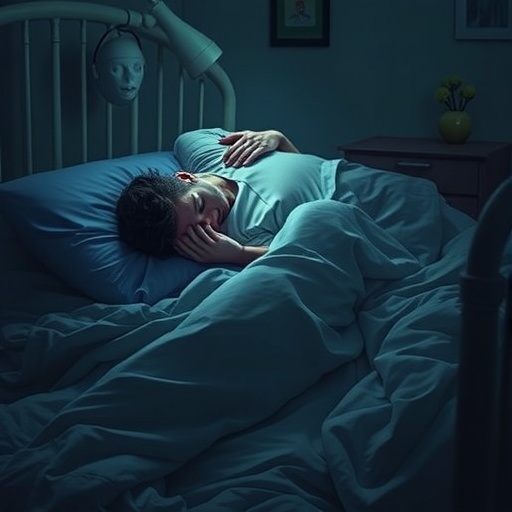In a groundbreaking case study published recently in BMC Psychiatry, researchers have shed light on a rare and disturbing phenomenon: sleep-associated violence manifesting as strangulation during the night. This investigation dives deep into the intersections of sleep medicine, psychiatry, and forensic science, revealing how complex and multifaceted the diagnosis of violent nocturnal behaviors can be. The implications are profound, especially for legal systems grappling with distinguishing criminal intent from involuntary pathological acts during sleep.
The case centers on a 60-year-old retired truck driver who presented no prior history of mental illness, violent behavior, or sleep disorders. His life took an alarming turn after he developed insomnia post-retirement and was prescribed a low dose (0.25 mg) of alprazolam, a benzodiazepine commonly used to aid sleep. Four days following the initiation of this medication, he was found strangling his sleeping wife at 5:30 a.m., an event that could have ended in tragedy had she not survived. This extraordinary incident prompted a judicial request for a comprehensive psychiatric and sleep medicine evaluation to elucidate the underlying causes.
The investigative team employed video-polysomnography (vPSG), a gold standard diagnostic tool in sleep medicine, to observe the patient’s sleep architecture and physiological parameters in real time, both with and without the administration of alprazolam. These recordings monitor brain waves, oxygen saturation, respiratory effort, muscle tone, and eye movements, providing a granular view of sleep stages and disruptions. The objective was to capture any abnormal nocturnal behaviors or electrical activity suggestive of epilepsy, parasomnias, or other neuropsychiatric conditions.
Remarkably, vPSG revealed no evidence of parasomnias such as arousal disorders or REM sleep behavior disorder (RBD), which are known to sometimes provoke violent movements during sleep. Equally, there was no indication of epileptic activity. Instead, the study unveiled severe obstructive sleep apnea (OSA) characterized by prolonged episodes of airflow cessation—apneas lasting up to 100 seconds—particularly during REM sleep, a phase typically associated with muscle atonia to prevent enactment of dreams.
The role of OSA in precipitating violent episodes is illuminating. The apnea-induced hypoxemia (oxygen deprivation) and the resultant fragmented sleep can engender acute confusional arousal states, where individuals awaken partially disoriented and may exhibit complex behaviors without conscious control. This phenomenon gains complexity when viewed through the lens of pharmacology: the exacerbation of OSA severity following benzodiazepine use is crucial. Alprazolam, while sedative, likely worsened respiratory depression, leading to deeper hypoxia and intensifying the confusion and aggression.
This constellation of factors led the expert panel to diagnose the nocturnal strangulation episode as a sudden confusional arousal triggered by severe OSA, compounded by the pharmacological effects of benzodiazepines. This diagnosis underscores the delicate balance within the brain during sleep and awakening states and how external influences can tip toward dangerous behaviors. Crucially, after cessation of alprazolam and initiation of appropriate OSA treatment, the patient experienced no further violent incidents, affirming the reversible and medical nature of his nocturnal aggression.
The forensic and clinical ramifications of this case are profound. In legal contexts, differentiating between intentional violent acts and those enacted involuntarily due to underlying neurological or sleep disorders is essential to ensure just outcomes. This case exemplifies the need for multidisciplinary collaboration and advanced diagnostics in forensic psychiatry, emphasizing that appearances can be deceiving, and what seems like attempted murder may instead be a manifestation of a treatable medical condition.
Beyond immediate clinical practice, this report invites a reevaluation of sleep’s role as a battleground where neurological, pharmacological, and psychological forces converge, sometimes with catastrophic consequences. It highlights the scientific necessity to understand not only sleep architecture but also the ways in which medications and comorbidities influence behavior during vulnerable sleep-wake transitions.
The rarity of such cases challenges researchers to develop more nuanced diagnostic criteria for violent parasomnias and related sleep-associated disorders. Future investigations might focus on the mechanistic underpinnings of confusional arousals, exploring neural circuitry, oxygen-desaturation thresholds, and the influence of differing sedative classes. This knowledge is vital to avoid misdiagnosis and to guide therapeutic decisions that protect patients and their communities.
From a public health perspective, the report raises awareness about the risks of benzodiazepines in patients with undiagnosed or untreated OSA. Given the widespread prescription of these agents for insomnia and anxiety, ensuring comprehensive sleep evaluations before medication initiation could prevent inadvertent exacerbation of sleep disorders and associated hazardous behaviors.
In summation, this case study vividly illuminates the interplay of sleep medicine and forensic psychiatry, demonstrating how severe OSA and benzodiazepine use can precipitate life-threatening nocturnal violence absent any underlying psychopathy or criminal intent. It challenges clinicians and the justice system alike to deepen their understanding of the enigmatic and powerful processes that govern sleep-related behavior. Through meticulous diagnostic rigor, remaining vigilant to unusual presentations, and fostering interdisciplinary collaboration, tragedies can be averted, and patients restored to healthy, peaceful lives.
As medical science progresses, cases like this will undoubtedly inform protocols that safeguard individuals prone to sleep-related violence, paving the way for precision medicine approaches in sleep disorders. The intersection of neurobiology, respiratory physiology, and pharmacology in the nocturnal landscape remains a fertile ground for discovery, with crucial implications not only for health but also for societal justice and safety.
Subject of Research: Sleep-associated violent behavior and its diagnosis in the context of psychiatric and sleep disorders, with a focus on obstructive sleep apnea and benzodiazepine use.
Article Title: Strangulation during the night: diagnosis of sleep-associated violence
Article References: Guerreiro, C., Chedru, F., Schenck, C.H. et al. Strangulation during the night: diagnosis of sleep-associated violence. BMC Psychiatry 25, 1046 (2025). https://doi.org/10.1186/s12888-025-07423-w
Image Credits: AI Generated
DOI: 10.1186/s12888-025-07423-w
Keywords: Sleep-associated violence, obstructive sleep apnea, benzodiazepines, confusional arousal, forensic psychiatry, polysomnography, parasomnia, REM sleep behavior disorder




